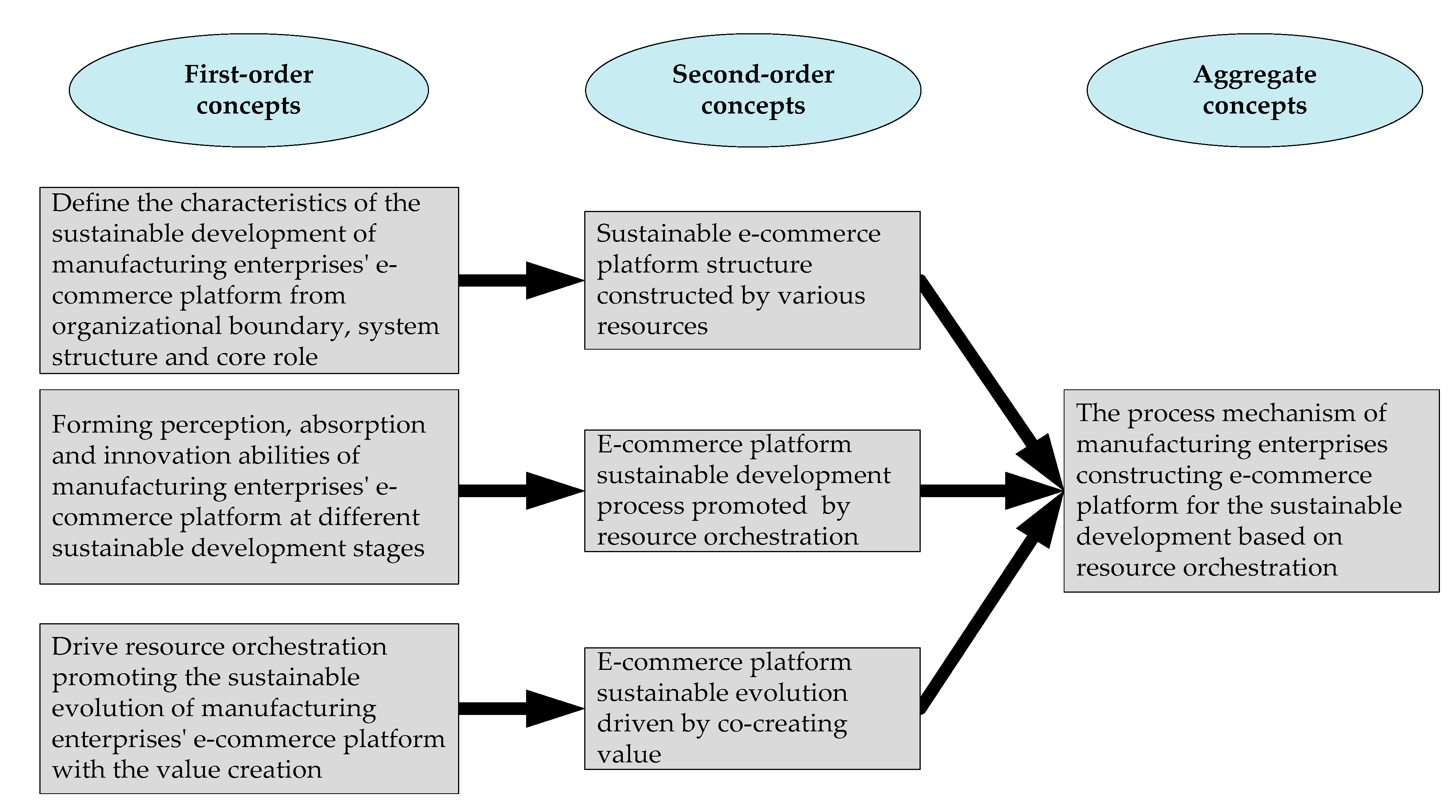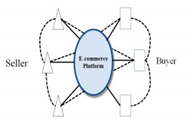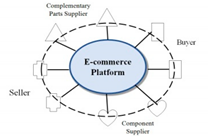How Do Manufacturing Enterprises Construct E-Commerce Platforms for Sustainable Development? A Case Study of Resource Orchestration
Abstract
:1. Introduction
2. Literature Review
2.1. E-Commerce Platform for the Sustainable Development: Concept and Construct Research
2.2. Resource Orchestration for the Sustainable E-Commerce Platform
2.3. Theoretical Analysis Framework
3. Analytical Method
3.1. Research Methods and Object Selection
3.2. Data Collection and Analysis
3.2.1. Data Collection
3.2.2. Data Analysis
4. Case Description and Findings
4.1. Initial Stage of the Sustainable E-Commerce Platform: Sales Channel
“Haier cooperated with third-party e-commerce platforms to attract more user groups for our sustainable development; at the same time cooperated with Baidu such a portal to achieve the matching of products and search, precision marketing.... Haier has built sustainable e-commerce platforms in various ways, so as to keenly perceiving the needs of the consumer market and making timely sales response according to user needs.”—Vice President of Haier Group
4.2. Growth Stage of the Sustainable E-Commerce Platforms: Service Differences
“The real network and virtual network of Haier is separated at first. But through the virtual-real integration, the sustainable developing resources of physical stores, regarding more than thirty thousand stores as wealth and the analysis of a large amount of data and ask for a lot of user needs, Haier finally implemented differentiation through the way of timely delivery and the final kilometer issue.”—Director of E-commerce Department
4.3. Development Stage of the Sustainable E-Commerce Platform: Innovation Incubation
5. Case Analysis and Discussion
5.1. Sustainable E-Commerce Platform Structure of Manufacturing Enterprises Constructed by Various Resources
“E-commerce is a sustainable platform to communicate with users, and it provides resource channels between manufacturers and users. Internet now actually gives Haier a good mirror for this kind of communication.”—Director of Strategic Planning Department
E-commerce is a good platform to communicate with users. By opening up the internal resource subjects and the external resource subjects of the industrial chain to achieve the integration of the real and the virtual, and also promote the interactive and sustainable development of resources between the buyers and sellers of the platform...—Director of Haier e-commerce
5.2. Resource Orchestration Promotes the Construction Mechanism of the Sustainable E-Commerce Platform Development of Manufacturing Enterprises
5.3. Co-Creating Value Is the Internal Driving Force of Resource Orchestration to Promote the Construction of the Sustainable E-Commerce Platform Development of Manufacturing Enterprises
“We attach great importance to users’ comments and satisfaction on sustainable e-commerce, which is a way to grasp the pulse of the times... as long as customers put forward demands, Haier will integrate manufacturing sustainable development technology and other resources globally, and find new market opportunities through interaction with users. After R&D and sales, we will continuously iterate and optimize products and services based on feedback.”—Vice President of Haier Group
6. Conclusions
6.1. Theoretical Contribution
6.2. Managerial Implications
6.3. Limitations and Future Research
Author Contributions
Funding
Conflicts of Interest
References
- Zhao, Y.; Zhou, Y.; Deng, W. Innovation mode and optimization strategy of B2C e-commerce logistics distribution under big data. Sustainability 2020, 12, 3381. [Google Scholar] [CrossRef] [Green Version]
- Li, C.; Liu, J.R.; Liu, Z.G.; Luo, X.G. Sustainable business model based on digital twin platform network: The inspiration from Haier’s case study in China. Sustainability 2020, 12, 936. [Google Scholar] [CrossRef] [Green Version]
- Leong, C.M.L.; Pan, S.L.; Newell, S.; Cui, L. The emergence of self-organizing e-commerce ecosystems in remote villages of China: A tale of digital empowerment for rural development. MIS Quart. 2016, 40, 475–484. [Google Scholar] [CrossRef]
- Inoue, Y.; Hashimoto, M.; Takenaka, T. Effectiveness of ecosystem strategies for the sustainability of marketplace platform ecosystems. Sustainability 2019, 11, 5866. [Google Scholar] [CrossRef] [Green Version]
- Tan, B.; Pan, S.L.; Lu, X.; Huang, L. The role of IS capabilities in the development of multi-sided platforms: The digital ecosystem strategy of Alibaba. com. J. Assoc. Inf. Syst. 2015, 16, 248–281. [Google Scholar] [CrossRef] [Green Version]
- Adner, R. Ecosystem as structure: An actionable construct for strategy. J. Manag. 2017, 43, 39–58. [Google Scholar] [CrossRef]
- Cui, M.; Pan, S.L. Developing focal capabilities for e-commerce adoption: A resource orchestration perspective. Inf. Manage. 2015, 52, 200–209. [Google Scholar] [CrossRef]
- Dandan, H.; Zhongfu, L.; Chunlin, W. An e-commerce platform for industrialized construction procurement based on BIM and linked data. Sustainability 2018, 10, 2613. [Google Scholar]
- Jiang, S.; Hu, Y.; Wang, Z. Core firm based view on the mechanism of constructing an enterprise innovation ecosystem: A case study of Haier Group. Sustainability 2019, 11, 3108. [Google Scholar] [CrossRef] [Green Version]
- Sirmon, D.G.; Hitt, M.A.; Ireland, R.D.; Gilbert, B.A. Resource orchestration to create competitive advantage: Breadth, depth, and life cycle effects. J. Manag. 2011, 37, 1390–1412. [Google Scholar] [CrossRef]
- Armstrong, M. Competition in two-sided markets. RAND J. Econ. 2006, 37, 668–691. [Google Scholar] [CrossRef] [Green Version]
- Rochet, J.C.; Tirole, J. Platform competition in two-sided markets. J. Eur. Econ. Assoc. 2003, 1, 990–1029. [Google Scholar] [CrossRef] [Green Version]
- Belleflamme, P.; Peitz, M. Managing Competition on a Two-Sided Platform. J. Econ. Manag. Strat. 2019, 28, 5–22. [Google Scholar] [CrossRef]
- Zeng, D.; Hu, J.; Ouyang, T. Managing Innovation Paradox in the Sustainable Innovation Ecosystem: A Case Study of Ambidextrous Capability in a Focal Firm. Sustainability 2017, 9, 2091. [Google Scholar] [CrossRef] [Green Version]
- Choi, J.P.; Zennyo, Y. Platform market competition with endogenous side decisions. J. Econ. Manag. Strat. 2019, 28, 73–88. [Google Scholar] [CrossRef] [Green Version]
- Bakos, J.Y. A strategic analysis of electronic marketplaces. MIS Quart. 1991, 15, 295–310. [Google Scholar] [CrossRef]
- Van den Broeke, M.M.; Boute, R.N.; Van Mieghem, J.A. Platform flexibility strategies: R&D investment versus production customization tradeoff. Eur. J. Oper. Res. 2018, 270, 475–486. [Google Scholar]
- Mäkinen, S.J.; Kanniainen, J.; Peltola, I. Investigating adoption of free beta applications in a platform-based business ecosystem. J. Prod. Innovat. Manag. 2014, 31, 451–465. [Google Scholar] [CrossRef]
- Deng, Z.; Wang, Z. Early-mover advantages at cross-border business-to-business e-commerce portals. J. Bus. Res. 2016, 69, 6002–6011. [Google Scholar] [CrossRef]
- Li, S.S.; Karahanna, E. Online recommendation systems in a B2C e-commerce context: A review and future directions. J. Assoc. Inf. Syst. 2015, 16, 72–91. [Google Scholar] [CrossRef] [Green Version]
- Miao, C.; Coombs, J.E.; Qian, S.; Sirmon, D.G. The mediating role of entrepreneurial orientation: A meta-analysis of resource orchestration and cultural contingencies. J. Bus. Res. 2017, 77, 68–80. [Google Scholar] [CrossRef]
- Barney, J. Firm resources and sustained competitive advantage. J. Manag. 1991, 17, 99–120. [Google Scholar] [CrossRef]
- Kozlenkova, I.V.; Samaha, S.A.; Palmatier, R.W. Resource-based theory in marketing. J. Acad. Market. Sci. 2014, 42, 1–21. [Google Scholar] [CrossRef]
- Yi, Y.; Li, Y.; Hitt, M.A.; Liu, Y.; Wei, Z. The influence of resource bundling on the speed of strategic change: Moderating effects of relational capital. Asia Pac. J. Manag. 2016, 33, 435–467. [Google Scholar] [CrossRef]
- Sirmon, D.G.; Hitt, M.A.; Ireland, R.D. Managing firm resources in dynamic environments to create value: Looking inside the black box. Acad. Manage. Rev. 2007, 32, 273–292. [Google Scholar] [CrossRef] [Green Version]
- Helfat, C.E.; Finkelstein, S.; Mitchell, W.; Peteraf, M.; Singh, H.; Teece, D.; Winter, S.G. Dynamic Capabilities: Understanding Strategic Change in Organizations; John Wiley & Sons: Hoboken, NJ, USA, 2009. [Google Scholar]
- Schriber, S.; Löwstedt, J. Managing asset orchestration: A processual approach to adapting to dynamic environments. J. Bus. Res. 2018, 90, 307–317. [Google Scholar] [CrossRef]
- Miguel, D.D.; Menchero, T.B.; Esteban-Navarro, M.N. Proximity trade and urban sustainability: Small retailers’ expectations towards local online marketplaces. Sustainability 2019, 11, 7199. [Google Scholar] [CrossRef] [Green Version]
- Hancock, D.R.; Algozzine, B. Doing Case Study Research: A Practical Guide for Beginning Researchers; Teachers College Press: New York, NY, USA, 2016. [Google Scholar]
- Eisenhardt, K.M.; Graebner, M.E. Theory building from cases: Opportunities and challenges. Acad. Manag. J. 2007, 50, 25–32. [Google Scholar] [CrossRef]
- Patton, M.Q. How to Use Qualitative Methods in Evaluation (No. 4); Sage: Thousand Oaks, CA, USA, 1987. [Google Scholar]
- Glaser, B.G.; Strauss, A.L. Discovery of Grounded Theory: Strategies for Qualitative Research; Routledge: New York, NY, USA, 2017. [Google Scholar]
- Eisenhardt, K.M. Building theories from case study research. Acad. Manag. Rev. 1989, 14, 532–550. [Google Scholar] [CrossRef]
- Pan, S.L.; Tan, B. Demystifying case research: A structured–pragmatic–situational (SPS) approach to conducting case studies. Inform. Organ. 2011, 21, 161–176. [Google Scholar] [CrossRef]
- Corbin, J.; Strauss, A. Grounded theory research: Procedures, canons, and evaluative criteria. Qual. Sociol. 1990, 19, 418–427. [Google Scholar]
- Gupta, A.; Briscoe, F.; Hambrick, D.C. Evenhandedness in resource allocation: Its relationship with CEO ideology, organizational discretion, and firm performance. Acad. Manag. J. 2018, 61, 1848–1868. [Google Scholar] [CrossRef]
- Van Alstyne, M.W.; Parker, G.G.; Choudary, S.P. Pipelines, platforms, and the new rules of strategy. Harv. Bus. Rev. 2016, 94, 54–62. [Google Scholar]
- Boyer, J. Toward an evolutionary and sustainability perspective of the innovation ecosystem: Revisiting the panarchy model. Sustainability 2020, 12, 3232. [Google Scholar] [CrossRef] [Green Version]
- Fan, Y.; Ju, J.; Xiao, M. Reputation premium and reputation management: Evidence from the largest e-commerce platform in China. Int. J. Ind. Organ. 2016, 46, 63–76. [Google Scholar] [CrossRef]
- Wang, W.T.; Wang, Y.S.; Liu, E.R. The stickiness intention of group-buying websites: The integration of the commitment–trust theory and e-commerce success model. Inform. Manag. 2016, 53, 625–642. [Google Scholar] [CrossRef]
- Muller, J.; Kiel, D.; Voigt, K. What drives the implementation of Industry 4.0? The role of opportunities and challenges in the context of sustainability. Sustainability 2018, 10, 247. [Google Scholar] [CrossRef] [Green Version]
- Felin, T.; Powell, T.C. Designing organizations for dynamic capabilities. Calif. Manag. Rev. 2016, 58, 78–96. [Google Scholar] [CrossRef] [Green Version]
- Frynas, J.G.; Mol, M.J.; Mellahi, K. Management innovation made in China: Haier’s Rendanheyi. Calif. Manag. Rev. 2018, 61, 71–93. [Google Scholar] [CrossRef]
- Xu, X.; Wang, L.; Zhao, K. Exploring determinants of consumers’ platform usage in “Double Eleven” shopping carnival in China: Cognition and emotion from an integrated perspective. Sustainability 2020, 12, 2790. [Google Scholar] [CrossRef] [Green Version]
- Ranjan, K.R.; Read, S. Value co-creation: Concept and measurement. J. Acad. Market. Sci. 2016, 44, 290–315. [Google Scholar] [CrossRef]
- Tantalo, C.; Priem, R.L. Value creation through stakeholder synergy. Strateg. Manag. J. 2016, 37, 314–329. [Google Scholar] [CrossRef]
- Crossler, R.E.; Posey, C. Robbing Peter to pay Paul: Surrendering privacy for security’s sake in an identity ecosystem. J. Assoc. Inf. Syst. 2017, 18, 487–515. [Google Scholar] [CrossRef]
- Chandna, V.; Salimath, M.S. Peer-to-peer selling in online platforms: A salient business model for virtual entrepreneurship. J. Bus. Res. 2018, 84, 162–174. [Google Scholar] [CrossRef]
- Porter, M.E.; Heppelmann, J.E. How smart, connected products are transforming competition. Har. Bus. Rev. 2014, 92, 64–88. [Google Scholar]
- Zhou, Q.; Chen, X.; Li, S. Innovative Financial Approach for Agricultural Sustainability: A Case Study of Alibaba. Sustainability 2018, 10, 891. [Google Scholar] [CrossRef] [Green Version]






| Interview Theme | Interviewees | Main Content |
|---|---|---|
| Virtual and Real Integration of Electronic Commerce Sustainable Business Strategy | Strategy Department of E-mail | Background, positioning and planning proposed by Haier sustainable development |
| Strategy Department of Group | Integration issue of Haier’s virtual net and real net | |
| Executive Vice President of the Group | Change of channels, confusion of Haier and the integration of people and orders in the process of sustainable development | |
| Marketing System which Supports the Virtual and Real Integration of Sustainable E-Commerce | Operating System of Haier, the Operating System of Integration of Virtual and Real | Issue of Haier’s multi-point contact, integration of virtual net and real net |
| Logistics, Service System which Supports the Virtual and Real Integration of Sustainable E-commerce | Interface of Logistics Business E-commerce, Interface of Service Business E-commerce | Independent management, interface issue of service, transformation of sustainable internal system; core follow of logistics, issue of 24 h and the last kilometer |
| Informatization of Sustainable E-commerce Platform | Mechanism Innovation Management | Challenges to PSI and node organization by sustainable network strategy |
| Virtual and Real Integration Operation, Interface of Logistics and Service | E-commerce sustainable development stage, mass customization | |
| E-commerce Department of White Home Appliances Group | Transformation of business process in the context of sustainable e-commerce, changes brought about by supply chain system and mechanism | |
| Business, Research, Development, Supply Chain System Related to White Home Appliances and Sustainable E-Commerce Platform | E-mail, Haier Research Center, | Problem of price, introduction of external resources, impact of virtual network on the market, and challenges under the sustainable network strategy |
| Stage | Initial Stage | Growth Stage | Development Stage | |
|---|---|---|---|---|
| Dimension | ||||
| Resource Cooperative Action | Buyer and seller conduct one-to-one cooperation on product/service resources through the sustainable e-commerce platform respectively. | Buyer and seller work or cooperate with one-to-one cooperation on product/ service resources through the sustainable e-commerce platform. | Different resources realize the co-creation and sharing of advanced technologies/ products through the sustainable e-commerce platforms. | |
| Organizational Resource Boundary | Clear | Partly Blurred | Blurred and Open | |
| Core Manufacturing Enterprise Role | Resource Provider | Resource Integrator | Resource Leader | |
| Main Structure Type |  Hub type |  Network type |  Symbiosis type | |
© 2020 by the authors. Licensee MDPI, Basel, Switzerland. This article is an open access article distributed under the terms and conditions of the Creative Commons Attribution (CC BY) license (http://creativecommons.org/licenses/by/4.0/).
Share and Cite
Hu, J.; Ouyang, T.; Wei, W.X.; Cai, J. How Do Manufacturing Enterprises Construct E-Commerce Platforms for Sustainable Development? A Case Study of Resource Orchestration. Sustainability 2020, 12, 6640. https://doi.org/10.3390/su12166640
Hu J, Ouyang T, Wei WX, Cai J. How Do Manufacturing Enterprises Construct E-Commerce Platforms for Sustainable Development? A Case Study of Resource Orchestration. Sustainability. 2020; 12(16):6640. https://doi.org/10.3390/su12166640
Chicago/Turabian StyleHu, Jingbo, Taohua Ouyang, William X. Wei, and Jiawei Cai. 2020. "How Do Manufacturing Enterprises Construct E-Commerce Platforms for Sustainable Development? A Case Study of Resource Orchestration" Sustainability 12, no. 16: 6640. https://doi.org/10.3390/su12166640
APA StyleHu, J., Ouyang, T., Wei, W. X., & Cai, J. (2020). How Do Manufacturing Enterprises Construct E-Commerce Platforms for Sustainable Development? A Case Study of Resource Orchestration. Sustainability, 12(16), 6640. https://doi.org/10.3390/su12166640






